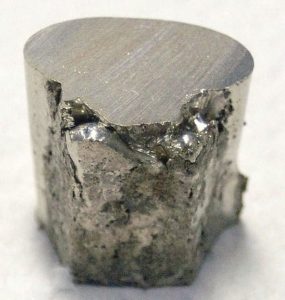C.S. & J.Y. Antique Cushion Cut and Antique Pear Shape Three Stone Ring + Split Shank Version

Cubic Zirconia has a bit of a bad rap. It’s often considered a cheap and obviously fake diamond alternative. But it has an interesting history and deserves props for being one of the many steps to smarter diamond alternatives today.
So where did cubic zirconia come from? According to LovetoKnow.com:
In 1937, two German mineralogists made an important discovery in Cubic zirconia’s history. The scientists found that melted zirconium oxide contained cube-shaped crystals. While this was a unique characteristic to any mineral, the men didn’t understand it as being anything useful since the same properties also existed in the mineral’s natural state. That redundancy seemed inconsequential to both men, and so they simply ignored their find. As with all scientific discoveries, the honor of naming the object or process is given to the one(s) making the discovery. In this case, neither man even considered naming their find, so cubic zirconia retained its scientific name. The world continued to overlook the mineral and its potential for several more decades.
It wasn’t until decades later that scientists”rediscovered” this simulated diamond, while searching for a less expensive material to be used with lasers and industrial applications–not for jewelry yet.
Finally, in 1977, Russian scientists discovered how to grow these crystals using a synthetic process. They named this synthetic crystal “Djevalite.” Under this name, they began to market them as simulated diamonds which took the jewelry world by storm at first.
CZ possesses two traits that prevent it from having an identical appearance to diamonds: CZ has more sparkles in rainbow colors than diamonds and also has more fire. CZ is more brittle and softer than a diamond. Regardless, it gave consumers the opportunity to wear a lot more bling for their buck.
Over the years, CZ has underwent some “bad press” because of its earlier cheap and often yellowish or greenish tints but, like other simulated diamonds, these synthetic gems have come a long way and seen substantial improvements in look and quality.

Synthetic cubic zirconia.
Radiance® Old Mine Cut and Antique Pear Diamond Engagement Ring from Joe Schubach on Vimeo.
The world of metals is vast and confusing. But we’re about to make it a little easier. Prepare yourself for some metal education !
Well, let’s talk about what stainless steel and sterling silver have in common first: both are alloys (meaning they are metals made up a combination of two other metals).
Now for the differences:
Stainless steel is made up of steel and chromium. It contains within it the strength and durability of steel with the luster, easy maintenance and resistance to corrosion of chromium. Stainless steel is used in surgical equipment, cookware, architecture and jewelry, among many other uses.
Sterling silver is made up of silver and another metal, most commonly copper, though potentially zinc or platinum. Silver by itself is too soft for most functional purposes, hence why its alloyed with another metal. This means it has the strength and functionality of the alloyed metal with the beautiful and lustrous appearance of silver.
Sterling silver is used to produce cutlery, jewelry, musical instruments (some manufacturers prefer to use sterling silver over brass).
Stainless Steel:
More scratch resistant than silver
Doesn’t tarnish
Less lustrous
Sterling silver:
Less scratch resistant than steel
Tarnishes
More lustrous
Lighter in weight
One of the main benefits of sterling silver is its appearance; it looks brighter and shinier. Stainless steel, on the other hand, is more durable and can last longer; it doesn’t tarnish but its also not as shiny.
Sterling Silver Tip: If you see a marking on that reads “.925,” this signifies the minimum fineness required for an object to be considered sterling silver.

A pure silver business card.
It’s a special occasion and you’re dressed to kill! Every hair is in place, your outfit is to die for and…you keep itching your neck all evening long.
Why? Your necklace (while it looks fabulous) is a piece of costume jewelry and not hypo-allergenic. Let the hives begin!
If your earrings, necklace or other piece of jewelry causes an itch or a rash on your skin, chances are you may be allergic to nickel.
It’s considered one of the most common skin allergies, mainly because nickel is used in so many items, including jewelry, cell phones, zippers, eyeglass frames, belt buckles and keys.
If you have a nickel allergy, you’ll notice symptoms 12 to 48 hours after you come into contact with it (though some notice symptoms earlier). Generally, the rash is specific to the area where the jewelry made contact but it can spread (sweat can worsen it, for example).
Take steps to avoid nickel contact. If you want piercings or tattoos, have it done with sterile, surgical-grade, stainless steel instruments. Take care to avoid piercing guns (since they can contain nickel and cause bacterial infections).
When you purchase jewelry, make sure its made of surgical grade stainless steel or either 24-karat yellow gold. Beware of white gold (which may contain nickel).
Other nickel-free metals? Pure sterling silver, copper, titanium and platinum. If you simply must wear earrings that have nickel in them, add plastic covers.

Nickel chunk.